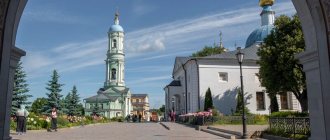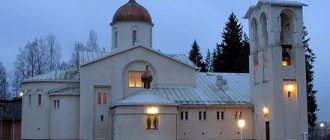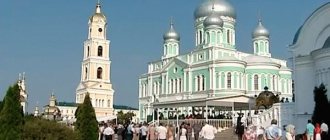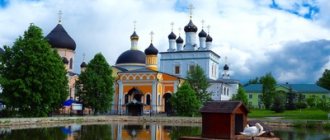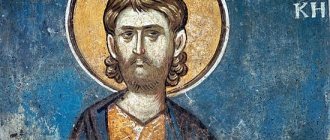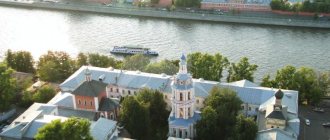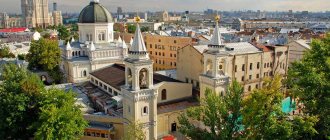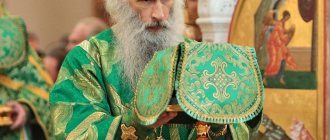Every deeply religious person considers it his duty to make a pilgrimage and worship religious shrines at least once in his life. For Orthodox Christians, such an opportunity will present itself during visits to churches and monasteries of the Golden Ring. The cities included in this route were founded many centuries ago, but to this day they have retained their beauty and grandeur. In addition, they still remain the spiritual heart of our Motherland.
A pilgrimage tour is not a simple excursion trip. Here the spiritual revival of a person, his soul, comes to the fore, and therefore such trips do not include worldly entertainment.
Pilgrimage trip along the Golden Ring - the unity of spirituality and culture
Cities of the Golden Ring
known not only in Russia, but also far beyond its borders. People from all over the world come here to experience religious and cultural values. During the tour you will visit the most beautiful churches, monasteries, attend religious services and have the opportunity to pray at miraculous icons. Here is a small list of holy places in the Golden Ring of Russia that pilgrims usually visit:
- Iversky Monastery
in Valdai. Prayer service at the miraculous icon of the Mother of God. It was written in 1854 to replace the lost one. - Trinity-Sergius Lavra
in Sergiev Posad. The relics of St. Sergius of Radonezh, the founder of many Russian monasteries, rest there. The formation of spiritual culture is associated with his name. The Trinity-Sergius Lavra is one of the main shrines of the Russian Orthodox Church, which is a UNESCO cultural world heritage site - Moore
. The relics of the famous saints Peter and Fevronia, heavenly patrons of love and family, are buried in the cathedral church. - Diveevo
. Burial place of St. Seraphim of Sarov, founder of the Diveyevo convent. Miraculous healings were reported many times near his grave. - Rostov the Great
. Spaso-Yakovlevsky Dimitriev Monastery. People come here to venerate the relics of Dmitry of Rostov, the intercessor of the Orthodox. - Pereslavl-Zalessky
. Here, in the village of Godenovo, is the Life-Giving Cross of the Lord, famous for its miracles. On the day of the Exaltation, believers from all over Russia, as well as from far abroad, come to him. - Suzdal
. Not far from it is the famous Temple of the Intercession on the Nerl. It is not only an ancient Orthodox shrine, but also a wonderful example of church architecture.
Where and when do they go?
If we divide pilgrimage tours on a regional basis, we can identify the destinations to which pilgrims most often go. This is, first of all, the North-West and Center of Russia, the most developed part of the country, which was back in the Middle Ages, during the emergence of Christianity and its development in Rus'. A lot of pilgrims go on trips along the Golden Ring, Zadonsk (Lipetsk region), Kursk and Diveevo (Nizhny Novgorod region) and, of course, to the North-Western region.
The North-West is not only Karelia (Valaam and Kizhi), but also Arkhangelsk (Solovki) and Vologda lands, Pskov and Veliky Novgorod. Pskov is interesting not only for the Pushkin Mountains and Pechora - besides them, many pilgrims visit the Talap Islands, where Father Nikolai Guryanov lived and served.
Most of the cities included in the Golden Ring of Russia are inextricably linked with the history of Orthodoxy in Rus': many shrines are concentrated in them, and almost every temple and monastery is an object of pilgrimage. The most visited cities are Alexandrov, Sergiev Posad, Pereslavl-Zalessky, Rostov Veliky, Yaroslavl, Tutaev, Uglich, Kostroma, Suzdal and Vladimir.
In addition, it is necessary to note such southern destinations as Rostov-on-Don, Krasnodar and Arkhyz - many monasteries have been restored and opened there recently. Altai occupies a special place; pilgrimages there are inextricably linked with the study of the traditions of local residents.
It is difficult to single out the most favorable time for travel. In summer they travel everywhere and for a longer period of time - from 3 to 7-12 days. In autumn and spring, as a rule, relatively short programs of 2-3 days are chosen. The only exceptions are major holidays: whether it’s a weekend or not doesn’t really matter.
1/
1
Kizhi Island- Valaam Monastery
Pilgrimage tours from Moscow
All Orthodox travel and pilgrimage tours are carried out from Moscow according to the established schedule. In addition to Russian cities, religious believers have the opportunity to visit holy places outside of Russia. The religious experience of generations in the countries of the Near Abroad brings great benefits of spiritual peace to travelers. Trips are planned so that believers can choose in advance the route of interest not on fasting days or at any convenient time. Taking a break from the bustle and remembering the origins of Orthodoxy is only a small part of what vacationers get on trips to shrines. In addition, for foreign pilgrimage tours the price remains within an affordable range.
Orthodox pilgrimage with a trusted company
The pilgrimage from Moscow is currently carried out in eight main directions. There are both multi-day and one-day routes. Geographically, PS "Peresvet" is located in Moscow and is an officially registered legal entity with extensive experience in the field of Orthodox pilgrimage. You can read briefly about our company, reviews and news on the main page of the official website, and see photo reports in the VKontakte group. You can quickly get any information about us by calling in Moscow 84959705709. Finally, if you wish, you can contact the director of the Peresvet pilgrimage service directly with a question or suggestion - for example, through the VKontakte group, or a form on the website.
Pilgrimage tours to Georgia
Georgia is one of the first countries that adopted Christianity and recognized it as the religion of the state. There are a large number of temples, monasteries, and ancient shrines on the territory. The holy springs of Georgia are known throughout the world. One of the most famous sources, which a large number of pilgrims come to visit, refers to the Georgian Enlightenment Nino, it is located on the territory of the Bodbe Monastery. Pilgrimage holiday in Georgia
will allow you to see shrines dating back to the 4th century, learn the stories of miraculous healings and miracles and see the creations of architecture.
The essence of pilgrimage
A pilgrimage is the journey of believers to places that are important and significant for their religion. Places that attract pilgrims are called sacred.
The objects of pilgrimage are:
- cities where a religious figure revered or lived was born or lived;
- prayer structures;
- holy relics;
- household items that have become shrines;
- icons and other images of a religious nature, etc.
Curiosity is not the only reason for such trips. People believe in the holiness of the places they visit and hope in this way to get even closer to God and feel his mercy.
Pilgrimages can be both collective and individual. Individual ones are often performed by hermits, ascetics, vowed monks, or people who have set a specific goal that they want to achieve with God's help.
Pilgrimage tours to Armenia
Christianity in Armenia dates back to the beginning of the 4th century (301) AD. The main cluster of holy places, monasteries and cathedrals can be seen in Etchmiadzin, Yerevan and nearby villages. Travel agency “Horizons” offers amazing pilgrimage tours to the holy places of Armenia
:
·
Khor Virap;
·
Noravank;
·
Geghard;
·
Tatev Monastery;
·
Gandzasar.
The religious tour will allow you to see the residence of the Catholicos, built in the 15th century, and enjoy the Orthodox beauty and tranquility of Armenia.
Pilgrimage tours to Serbia
The Christian religion of Serbia is very rich in Orthodox temples, churches and shrines. Serbian monasteries have a deep history, and the mass baptism of Serbs was recorded in chronicles at the beginning of the 7th century AD. Pilgrimage trips around Serbia
will reveal to believers the unique history of the formation of Christianity over many centuries. After all, the history of Serbian Orthodoxy suffered many schisms and pressure from the Turks and Roman Catholics. At the moment, a religious trip to Serbia will allow you to feel the spiritual meaning on the territory of the cathedrals and get a lot of impressions for spiritual experience. The troubled past and the emergence of Christianity of the Serbs attracts many religious tourists. Therefore, many are already planning pilgrimage tours for 2021.
Pilgrimage tours to Greece
The Greek Orthodox religion is one of the most revered in the world. It was Greece that played an important role in the history of Christianity at a time when many believers sought refuge and shelter from the Ottoman Empire. If you get to know this country more closely, then trips to holy places will allow you to see the rarest icons, temples, and monasteries that have contributed to Christianity at the world level. Throughout history, Christianity in Greece suffered many raids, fires, holy relics were transferred many times from Orthodox to Muslims to Catholics. But most of the shrines have been preserved and are now open to visit by modern generations. The pilgrimage tour of the tour operator “Horizons” to Greece will reveal the high spiritual power of Christianity of the times and generations that this country has carefully preserved.
Pilgrimage in Russia: paths and traditions
In the history of human civilization, movement on planet Earth is not something outlandish. People have always moved in search of a better life, and even now they travel to discover the world and understand existence. But among this host of wanderers, those who had a special goal that they sought to achieve stood out. This goal is not very clear to the ordinary secular person. But on the other hand, it is understandable to an initiate and is amazing in the depth of its essence and spiritual content.
The bright land of Palestine...
related to me since childhood!
P.A. Vyazemsky
What kind of people are they who are called “pilgrims”, and their movement around the world is called “pilgrimage”? How many are there, what are their motives, why are their traditions so important, for example, in the history of Russia?
Let's start with the main thing - where and how the words-terms “pilgrim” and “pilgrimage” appeared. The answer lies at the very root of these words. This root is “palm”, yes, that same palm is a tree that grows in the southern regions. Anyone who professes Orthodoxy or is committed to Christianity will immediately understand what the essence of the matter is. The palm branch is the most important Christian symbol. It is connected with the Gospel history and the events of the beginning of our era, when the Entry of the Lord into Jerusalem took place and when people met Jesus Christ at the entrance to the city with palm branches in their hands. In Russia, the day of remembrance of this – the Sunday preceding Easter – is called “Palm Day”. Willow branches replaced the palm tree that was missing in Ancient Rus'. But the word “loosestrife” does not exist in everyday life. There is precisely a “pilgrim”, a person who has a palm branch. And this means that he really was in the Holy Land, worshiped the Holy Sepulcher, the shrines of Jerusalem, held a palm tree in his hands, or even brought it back home with him. Some Christian saints are depicted with a palm branch in their hands; the palm tree has become a symbol of martyrdom, purity and victory over death.
Among Western, European Christians, the word “pilgrim” did not take root. They called and still call those who traveled to the Holy Land pilgrims, from the Latin word peregrinus, that is, “foreigner” or “wanderer.” In any case, pilgrimage as such is associated with the worship of famous places of earthly suffering and the Divine glory of Jesus Christ; this is a centuries-old church custom, as well as a wide socio-historical and cultural phenomenon.
From the very appearance of pilgrimage in Russia (and on a more or less mass scale it began to occur after Russia adopted Christianity in the 10th century), those who set out on a difficult and even life-threatening journey recorded their impressions and left notes to talk about their impressions to others. Gradually, this experience became a tradition. Pilgrimages in Rus' were also called “walkings” (or “walkings”). Texts of memoirs gradually formed a genre of ancient Russian literature, which also included smaller genres, such as ancient guidebooks, essays, individual notes or even letters.
More than 70 such unique “circulations” have survived to this day, the texts of which were multiplied among readers, as evidenced by their numerous lists. A concise, diary type of retelling of events that took place, a fairly accurate description of holy places, and instructiveness - these were the features that distinguished these works.
Of the most famous and important ancient Russian “walks” of the XII-XVI centuries, the most famous are those associated with the initial visit to Constantinople - Constantinople - the great capital of the Orthodox world of that time. From there, pilgrims often (though not always) strove to the Holy Land. Here are just a few of them that had a huge impact on the pilgrimage tradition in Medieval Rus': “The Walk of Daniel to Constantinople”, “The Walk of Anthony of Novgorod to Constantinople”, “The Walk of Ignatius of Smolnyanin to Constantinople”, “Pimenov’s Walk to Constantinople”, “The Walk of Stefan of Novgorod” ", "Walking of the unknown Suzdal resident", "Walking of Barsanuphius", "Walking of the guest Vasily", "Walking of Zosima" and "Walking of Abraham of Suzdal". The very name of such notes also gave rise to many works that are not directly related to pilgrimages, but have become a symbol of extensive travel around the world. The most famous of these works is “Walking across Three Seas” by Afanasy Nikitin - notes of a merchant who discovered the East, but did not set his goal at that time to visit the Holy Land.
As we see, highly respected people became pilgrims or authors of “walkings” in Medieval Rus' - monastics, clergy or bishops, people from the boyar or later merchant (“guest”) strata of the population. In any case, we have almost no written evidence about peasant pilgrims. Does this mean that such a journey was too expensive and dangerous, that it was almost impossible to carry it out alone? This is exactly the answer to this question that we are forced to give.
And after 1453, when Constantinople fell and the Ottomans captured the entire Middle East, pilgrimage to the Holy Land from North-Eastern Rus' became almost impossible. Numerous reports of the deaths of daredevils who went to Jerusalem temporarily stopped the tradition, which by that time had already become fundamental in many ways.
In the 16th and 17th centuries, the tradition of pilgrimage to the East began to resume. But during the waiting period, amazing changes appeared in the consciousness of the Russian people. In Russia itself, signs of Paradise began to be found, reminiscent of the Holy Land. Now it was not necessary to strive at all costs to become a pilgrim who reached the lands where the gospel events took place. Visiting Russian shrines was also identified with pilgrimage. Moreover, the idea of a New Jerusalem, founded in the era of Sergius of Radonezh, was developed. In the difficult history of Ancient Rus', wars, pestilences or natural disasters did not stop for almost a single year, and the Horde yoke “slowed down” the development of the state for several centuries. It was these ordeals that became the basis for the appearance in the people’s understanding of the world of a peculiar belief, a legend about a city where all these difficulties, troubles and misadventures never happened or never will happen. Moreover, such a city could exist both in reality and in the imagination, or, again, following the language of modernity, in virtual space.
For a believer - a Christian - the image of such a city of refuge was, first of all, the Heavenly City of Jerusalem - a prototype of the future life of a person that awaits him after completing his worldly path. For a person who has not parted with some pagan ideas about nature, such a place has become the symbol of the city of Kitezh, reborn from the ashes - hidden or hiding from prying eyes, saved and saved from enemies, not surrendering to the conquerors, disappearing from the visible earthly space, sinking to the bottom of the sacred lake , but at the same time - miraculously preserved and at the same time preserving all its inhabitants. The search for such a city on earth has been the aspiration of many generations of dreamers. And if it could not be found, then it was quite possible to try to create and build it in reality.
In some ways, the prototypes of such Heavenly cities were, for example, monasteries under construction - monasteries where some people went away from worldly concerns, refusing to participate in worldly “atrocities.” Here they, with newly acquired monastic names, created a new way of life, internal, self-absorbed, meditative, hesychast. The northern Thebaid of new monasteries, created during the time of Sergius of Radonezh in Moscow, and then by his disciples and followers, greatly increased the feeling of confidence and protection from life’s misfortunes among the Russian people. It was in those years that, in our opinion, a barely visible, unusual and not clearly formulated idea appeared in the Russian spiritual environment: the Heavenly City in the center of the Russian land.
The sacred space of Russian Palestine in those days initially had only spiritual, and not material, outlines. Two Jerusalems were already known in time: one is historical, “old”, the other, built by the Byzantine emperor Constantine, “new”. Back in 355, he consecrated “the New Jerusalem predicted by the prophets, the temple of the Savior,” when the “old,” dilapidated, real—biblical, following the remark of Eusebius, the emperor’s biographer—“was turned into extreme desolation and suffered punishment.” The idea of the Third Jerusalem, like the idea of the Third Rome, began to appear in its entirety in Rus', and then in Russia. The idea of Russian Palestine has long appeared in the Russian popular consciousness even in the emerging and developing “Sergian” monastic environment. Rus' itself became in the minds of people a prototype of Palestine, and the concepts of homeland and fatherland were perceived not only as earthly or territorial, but no less, and even more so, as spiritual. That’s why there was a popular saying: “in our Palestines,” which, in essence, meant “at our home, in our homeland.”
The construction of the New Jerusalem monastery in the 17th century also becomes clear. Patriarch Nikon made his dreams come true and built his “aspiration” - the prototype of the Church of the Holy Sepulcher next to the capital - Moscow, even renaming the Istra River Jordan. We have all the signs of searching for Paradise among the Russian land. Let us recall the records of Abbot Daniel, who wrote about his “walk” to Jerusalem at the beginning of the 12th century, having learned, in his opinion, what Paradise is. He cites the following phrases: “Wonderful and wondrous and unspeakably and red,” “that land is beautiful and unspeakable to everyone,” “wonderful and unspeakably cunning.” Palestine is almost always flowering trees, “abundant fruits, clean and sweet spring waters, a diverse fauna, high,” as well as a bright light from above, an amazing radiance that is not easy for an earthly person to withstand. The garden city, “planted paradise,” is always mentioned.
This is how the tradition of pilgrimage within the country was established in Russia. It was no longer necessary to go far away. You could visit monasteries and holy places at home. And now even these people - who had never visited the Holy Land - began to be called pilgrims.
Pilgrimage to places of holiness - wherever it is manifested - has become a normal part of the ordinary life of an Orthodox person. And the distant Holy Land became spiritually dear, to such an extent that Rus' itself became Holy.
Does this mean that the tradition of visiting Jerusalem has ceased? Of course not, it developed later, especially in the 19th century, when new opportunities, options and ways of delivering pilgrims to their long-awaited goal appeared.
The highest couple, Grand Duke Sergei Alexandrovich and his wife, Grand Duchess Elizaveta Feodorovna, put a lot of effort into this.
What was the essence of the changes?
To begin with, let's say that pilgrimage traditions were cultivated in the families of Russian tsars and emperors. The sovereigns, their wives and children repeatedly visited holy places in Russia. An example of this can be the Zvenigorod Savvino-Storozhevsky Monastery, close to Moscow. All the leaders of the Russian state visited him. It is no coincidence that Saint Savva almost immediately after his death became known as the “Patron of God’s Chosen Kings.” The royal power could not be self-proclaimed, but only sent down from above. Immediately after the canonization of the Zvenigorod Wonderworker at the Council in 1549 and the anointing of the Kingdom (the announcement of Ivan the Terrible as the first Russian Orthodox Tsar), a mandatory tradition appeared - visits by monarchs to the Zvenigorod monastery. The monastery of Savva Storozhevsky becomes not just a place of pilgrimage, but an unusual sacramental center for confirming the divine choice of the head of state. Even the wife of False Dmitry II, Marina Mnishek, followed to worship the Zvenigorod Elder in order, as the Poles believed, to receive “great respect” from the Russian people. The kings of the new Romanov dynasty recognized the Savin Monastery as worthy of more serious worship, and its founder as the patron of the royal family and “prayer book for God’s chosen Kings.” The supreme rulers of Russia regularly visited the monastery and invested considerable funds there. The tradition was preserved throughout the entire period of the existence of Imperial Russia.
And this is just one example. And there are hundreds of them! In the 19th century, the opportunity arose for ordinary people to visit Jerusalem, the Holy Land. The number of pilgrims from Russia began to number in the thousands! Throughout the century, members of the imperial family also repeatedly visited those parts and joined the ranks of pilgrims. However, compared to the majority, it was just more difficult for them to get to the Holy Land. This was due to political problems. For this reason, having repeatedly intended to make a pilgrimage to the Holy Sepulcher, neither, for example, Empress Maria Alexandrovna nor Emperor Nicholas II could do so. However, some great princes made such trips until the beginning of the 20th century.
In the 19th century, a period of permanent Russian presence in Palestine began. It was based on an event - the arrival of the Grand Dukes Sergei and Pavel Alexandrovich with Konstantin Konstantinovich to the Holy Land in May 1881. The most august pilgrims visited the Mount of Olives (the Russian Church of the Ascension of the Lord was built there) and spent the night at the Holy Sepulcher. The head of the Russian Ecclesiastical Mission in Jerusalem, Archimandrite Antonin (Kapustin), then proposed the idea of building a church of St. Equal to the Apostles Mary Magdalene. The location was chosen in the upper part of the Garden of Gethsemane on the slope of the Mount of Olives. The funds were allocated by the imperial family. The temple was consecrated later, in 1888, in the presence of the Grand Dukes Sergei and Pavel Alexandrovich, who again visited the Holy Land, as well as the Grand Duchess, the future Martyr Elizabeth Feodorovna (she is now buried in this temple).
Grand Duke Sergei Alexandrovich immediately noticed the difficulties facing the Orthodox in Palestine, as well as the helpless situation of Russian pilgrims there. This is how the idea of creating a Society to help Russians in the Holy Land emerged. In 1882, the Imperial Orthodox Palestine Society (IPOS) was established in St. Petersburg to help organize trips of Russian pilgrims to holy places (Palestine, Athos, Bari), as well as to develop science about the past and present of the Holy Land and its popularization. Grand Duke Sergei Alexandrovich was elected chairman of the IOPS. Its honorary members then became prominent representatives of Russian society, members of the imperial family, members of the government, chief prosecutors of the Holy Synod, governors and vice-governors, diocesan bishops and representatives of the creative elite. Money was collected all over Russia. Every year on Palm Sunday (pilgrim day), a collection was held in churches and monasteries of the Russian Empire to support Russian Palestine.
The route to the Holy Land was significantly reduced in cost, and convenient routes were developed with the possibility of overnight stays and stops. They acquired new plots of land, built churches, farmsteads, hospitals and schools. The houses of the IOPS in Jerusalem and other cities contained dining rooms, reading rooms, shops, laundries and baths. By the beginning of the 20th century, the society helped hundreds of thousands of Russian pilgrims visit the Holy Land. A circle of assistant guides appeared who knew Turkish and Russian, which was important when crossing Turkish territories. The society opened more than a hundred Russian schools for the population of Palestine, Syria and Lebanon, in which thousands of children studied the Russian language and the Law of God, many of whom later became famous cultural figures in their countries.
On the way to Palestine from Russia, pilgrims often found themselves on Turkish territory in the Lycian World, where in ancient times St. Nicholas the Wonderworker, especially revered by the Russians, served. For this reason, a plot of land here was purchased in 1853 for pilgrims. Money was collected for its reconstruction, including the temple. But due to political problems, the temple was never restored. Although there is money left. In 1910, they decided to give them to the construction of a Russian farmstead in Bari (Italy). Another important destination for pilgrimage from Russia has emerged - to Italy. We must thank Grand Duchess Elizabeth Feodorovna for this, who took up this issue after the murder of her husband. After venerating the Holy Sepulcher, pilgrims considered it important to venerate the tomb of St. Nicholas, despite great difficulties. A plot of land was also purchased in Bari, Italy. Temple and courtyard according to the plan of A.V. Shchusev was built. But under Soviet rule, in 1931, it was sold to the Italians. However, already in our time, in 2009, everything returned to its place, and pilgrims today can freely visit again “their” Russian temple, where the relics of St. Nicholas rest.
Currently, pilgrimage from and to Russia is highly developed. There are no obstacles to this. Times like these did not often spoil supporters of compulsory visits to holy places. Therefore, it is worth hurrying in order to, together with a host of predecessors, see with your own eyes and feel with your soul the great monuments and lands where cosmic events took place that laid the foundation not only for human civilization, but for the entire Universe. The honorary “title” of a pilgrim is an introduction to high culture, spirituality and the richness of the worldview, which can be comprehended if you treat this matter as an important part of your whole life, not wasted on empty adventures or inglorious deeds of a one-day nature.
A pilgrim is a person who joins Eternity. He strives towards the intended goal of worship with prayer, fasting and repentance. He makes his main journey at least once, including into the depths of his soul, and therefore is unlikely to remain indifferent after completing the route to a world that has unexpectedly transformed for him, in which the Path, the Truth, and Life have long been accurately indicated.
Organizing a trip to holy places
The travel time is planned taking into account visiting church services: everyone can attend the all-night vigil and attend the morning liturgy at dawn. If desired, the faithful may be accompanied on their journey by a priest. Guides must meet special requirements:
- godly behavior;
- belonging to the Orthodox faith;
- deep understanding of the spiritual component of pilgrimage.
It is very important to follow the rules for visiting temples and monasteries. First of all, this concerns clothing:
- For women, a headdress is required: a scarf or headscarf and a long skirt covering the knees. Clothing should be modest, discreet, shoulders and chest must be covered;
- for men – also a closed torso and shoulders. Jeans or trousers would also be appropriate. Wearing shorts and hats is considered inappropriate.
In addition, drinking alcoholic beverages is not allowed. Try to refrain from using bad language.

